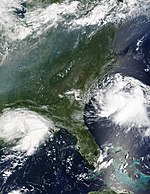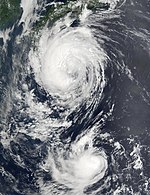Tropical cyclones in 2002
| Tropical cyclones in 2002 | |
|---|---|
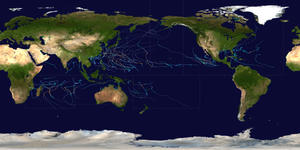 Year summary map | |
| Year boundaries | |
| First system | Cyprien and Bernie |
| Formed | December 30, 2001 |
| Last system | Delfina |
| Dissipated | January 9, 2003 |
| Strongest system | |
| Name | Zoe |
| Lowest pressure | 890 mbar (hPa); 26.28 inHg |
| Longest lasting system | |
| Name | Kyle |
| Duration | 22 days |
| Year statistics | |
| Total systems | 121 |
| Named systems | 78 |
| Total fatalities | 1,068 total |
| Total damage | $12.42 billion (2002 USD) |
During 2002, tropical cyclones formed within seven different tropical cyclone basins, located within various parts of the Atlantic, Pacific and Indian Oceans. During the year, a total of 123 tropical cyclones formed, of which 80 tropical cyclones developed enough to be named by either a Regional Specialized Meteorological Center (RSMC) or a Tropical Cyclone Warning Center (TCWC). The strongest system was Cyclone Zoe, with a barometric pressure of 890 hPa (26 inHg). The costliest and deadliest tropical cyclone of the year was Typhoon Rusa, killing 238 in South Korea and causing $4.2 billion (2002 USD) in damages. 26 Category 3 tropical cyclones, including eight Category 5 tropical cyclones formed in 2002. The accumulated cyclone energy (ACE) index for the 2002 (seven basins combined), as calculated by Colorado State University was 812 units.
Tropical cyclone activity in each basin is under the authority of an RSMC. The National Hurricane Center (NHC) is responsible for tropical cyclones in the North Atlantic and East Pacific. The Central Pacific Hurricane Center (CPHC) is responsible for tropical cyclones in the Central Pacific. Both the NHC and CPHC are subdivisions of the National Weather Service. Activity in the West Pacific is monitored by the Japan Meteorological Agency (JMA). Systems in the North Indian Ocean are monitored by the India Meteorological Department (IMD). The Météo-France located in Réunion (MFR) monitors tropical activity in the South-West Indian Ocean. The Australian region is monitored by five TCWCs that are under the coordination of the Australian Bureau of Meteorology (BOM). Similarly, the South Pacific is monitored by both the Fiji Meteorological Service (FMS) and the Meteorological Service of New Zealand Limited. Other, unofficial agencies that provide additional guidance in tropical cyclone monitoring include the Philippine Atmospheric, Geophysical and Astronomical Services Administration (PAGASA) and the Joint Typhoon Warning Center (JTWC).
Global atmospheric and hydrological conditions
[edit]In the seven basins, there are a variety of different factors that impact tropical cyclogenesis. One of the most important factors is the presence or lack of El Niño–Southern Oscillation, which was present for much of the second half of 2002.[1][2] El Niño is caused by the replacement of the Walker circulation by the Hadley circulation. This leads to the formation of a band of warm ocean water in the equatorial Eastern Pacific basin, marked by a reduction in upwelling.[3]
The El Niño phenomenon has global effects on cyclone formation, development, and tracks. In the Atlantic Ocean, El Niño years see less active hurricane seasons due to stronger westerly winds, which cause increased vertical wind shear, inhibiting cyclonic development.[4] By contrast, the Eastern Pacific basin exhibits lower wind shear and higher sea surface temperatures, leading to more active cyclone seasons. In the Western Pacific, tropical cyclone formation shifts eastward, without a major change in activity; thus, a typhoon that would normally affect China might shift to instead impact Micronesia.[4] In the Southern Hemisphere, the situation in the Northern Hemisphere is mirrored: the Australian region sees fewer cyclones, while the South Pacific becomes more active.[5] All these factors were present in 2002: the Atlantic hurricane season was slightly below-average,[6] the Eastern Pacific had an unusually high number of major hurricanes,[7] the Western Pacific saw a dearth of activity in the South China Sea in conjunction with an abnormally strong subtropical ridge,[8] and the Australian region saw no storms in the second half of 2002,[9] while the South Pacific season was one of the most intense on record.[10]
Seasonal summary
[edit]
North Atlantic Ocean
[edit]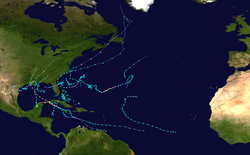
The season produced fourteen tropical cyclones, of which twelve developed into named storms; four became hurricanes, and two attained major hurricane status. While the season's first cyclone did not develop until July 14, activity quickly picked up: eight storms developed in the month of September. It ended early however, with no tropical storms forming after October 6—a rare occurrence caused partly by El Niño conditions. The most intense hurricane of the season was Hurricane Isidore with a minimum central pressure of 934 mbar, although Hurricane Lili attained higher winds and peaked at Category 4 whereas Isidore only reached Category 3.
The season was less destructive than normal, causing an estimated $2.47 billion (2002 USD) in property damage and 23 fatalities. Most destruction was due to Isidore, which caused about $1.28 billion (2002 USD) in damage and killed seven people in the Yucatán Peninsula and later the United States, and Hurricane Lili, which caused $1.16 billion (2002 USD) in damage and 15 deaths as it crossed the Caribbean Sea and eventually made landfall in Louisiana.
Eastern Pacific Ocean
[edit]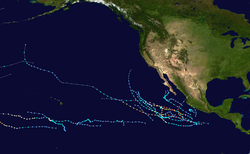
The season was slightly above average as it saw three tropical cyclones reach Category 5 intensity on the Saffir–Simpson scale, tied for the most in a season with 1994 and 2018. The strongest storm this year was Hurricane Kenna, which reached Category 5 on the Saffir–Simpson scale. It made landfall near Puerto Vallarta, located in the Mexican state of Jalisco, on October 25. Elsewhere, Tropical Storm Julio made landfall in Mexico, and Tropical Storm Boris dumped torrential rain along the Mexican coast, despite remaining offshore.
Other storms were individually unusual. Hurricanes Elida and Hernan also reached Category 5 intensity, but neither caused any damage. Hurricane Fausto had no effect on land, but it regenerated into a weak tropical storm at an abnormally high latitude.
Western Pacific Ocean
[edit]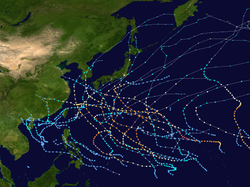
The season was slightly above average with many tropical cyclones affecting Japan and China. Every month had tropical activity, with most storms forming from July through October. Overall, there were 44 tropical depressions declared officially or unofficially, of which 26 became named storms; of those, there were 15 typhoons, which is the equivalent of a minimal hurricane, while 8 of the 15 typhoon intensified into super typhoons unofficially by the JTWC. The season began early with the first storm, Tapah, developing on January 10, east of the Philippines. Two months later, Typhoon Mitag became the first super typhoon [nb 1] ever to be recorded in March. In June, Typhoon Chataan dropped heavy rainfall in the Federated States of Micronesia, killing 48 people and becoming the deadliest natural disaster in the state of Chuuk. Chataan later left heavy damage in Guam before striking Japan. In August, Typhoon Rusa became the deadliest typhoon in South Korea in 43 years, causing 238 deaths and $4.2 billion in damage.[nb 2] Typhoon Higos in October was the fifth strongest typhoon to strike Tokyo since World War II. The final typhoon of the season was Typhoon Pongsona, which was one of the costliest storms on record in Guam; it did damage worth $700 million on the island before dissipating on December 11.
The season began early, but did not become active until June, when six storms passed near or over Japan after a ridge weakened.[12] Nine storms developed in July, many of which influenced the monsoon trough over the Philippines to produce heavy rainfall and deadly flooding.[13] The flooding was worst in Luzon, where 85 people were killed. The series of storms caused the widespread closure of schools and offices. Many roads were damaged, and the floods left about $1.8 million (₱94.2 million PHP)[nb 3] in crop damage, largely to rice and corn.[14] Overall damage from the series of storms was estimated at $10.3 million (₱522 million PHP).[15][nb 3] From June to September, heavy rainfall affected large portions of China, resulting in devastating flooding that killed over 1,500 people and left $8.2 billion (¥68 billion CNY) in damage.[17][nb 4] During this time, Tropical Storm Kammuri struck southern China with a large area of rainfall that damaged or destroyed 245,000 houses. There were 153 deaths related to the storm, mostly inland in Hunan,[18] and damage totaled $322 million (¥2.665 billion CNY).[19][nb 4] Activity shifted farther to the east after September, with Typhoon Higos striking Japan in October and Typhoon Pongsona hitting Guam in December.[12]
During most of the year, sea surface temperatures were above normal near the equator, and were highest around 160° E from January to July, and in November. Areas of convection developed farther east than usual, causing many storms to develop east of 150° E. The average point of formation was 145.9° E, the easternmost point since 1951. Partially as a result, no tropical storms made landfall in the Philippines for the first time since 1951, according to the JMA. Two storms – Ele and Huko – entered the basin from the Central Pacific, east of the International Date Line. Overall, there were 26 named storms in the basin in 2002, which was slightly below the norm of 26.7. A total of 15 of the 26 storms became typhoons, a slightly higher than normal proportion.[12]
North Indian Ocean
[edit]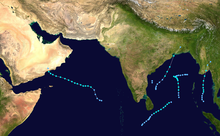
The season was below average, with only seven tropical cyclones, four cyclonic storms, and one severe cyclonic storm.[20] The first storm, in the Arabian Sea, formed on May 6 from a low-pressure area.[20] It went on to strengthen into a weak cyclonic storm, being designated ARB 01, and make landfall in Oman four days later, causing intense damage. ARB 01 simultaneously dissipated.[20] The rest of May featured two tropical depressions. The first, according to the JTWC, reached tropical storm-equivalent strength[21] and made landfall in Myanmar.[20] The second was recognized only by the Thailand Meteorological Department and was not given a number.[22] There was no activity in June, July, August, or September, the first instance of such in the history of the IMD.[23] Then, on October 22, Depression BOB 02 formed. It did not intensify and dissipated two days later.[20] No storms formed again until BOB 03 on November 10. This storm strengthened into a severe cyclonic storm, before making landfall in West Bengal two days later and dissipating. Like all the other storms in the season, BOB 03 failed to reach hurricane strength.[20] Two more cyclonic storms formed in the Bay of Bengal. BOB 04 was in late November and did not affect land.[20] BOB 05 formed very far south on December 21, scraped Sri Lanka, and dissipated in the open bay.[20]
South Pacific Ocean
[edit]2001–02
[edit]2002 began with two storms active in the basin: Severe Tropical Cyclone Waka and Tropical Depression 05F. Waka, at the time, was a Category 4 severe tropical cyclone near Niue.[24] Waka dissipated on January 2, and nothing formed but tropical depressions until Severe Tropical Cyclone Claudia entered the basin on February 12. Claudia rapidly weakened and dissipated two days later.[24][25] The next tropical cyclone, Des, also crossed over, on March 5.[24] Due to unfavorable conditions, Des soon dissipated.[26] Following Des's dissipation, four official and one unofficial tropical depression formed. The season ended on April 22.[24]
The 2001–02 season was one of the least active on record.[27]
2002–03
[edit]The season began very early, starting with Tropical Depression 17F on July 3.[28] After that, however, the season was quiet, with one tropical depression forming in mid October. By November, a tropical cyclone, Yolande had formed, as well as another tropical depression.[28] In December, activity sped up, with Cyclone Zoe, a Category 5 severe tropical cyclone, forming.[28]
With seven severe tropical cyclones in total, the 2002–03 season was one of the most active ever recorded.[29]
Australian region
[edit]2001–02
[edit]On 1 January 2002, Tropical Cyclone Bernie had just formed near Northern Territory.[30] Bernie made landfall in Northern Territory four days later, causing minor damages, and then dissipated.[30] Then, on 2 February, Tropical Cyclone Chris formed. It rapidly intensified into a Category 5 severe tropical cyclone.[31] On 6 February, Chris made landfall in Western Australia,[32] and dissipated later in the day. Chris caused 12 deaths and some damage.[31][33] Five days later, Tropical Cyclone Claudia formed, and dissipated without affecting land.[33] After another tropical low, Tropical Cyclone Des formed on 4 March near Papua New Guinea.[26] Three days later, Des crossed over to the South Pacific.[26]
After Des, the season was quiet until a tropical cyclone was named Dianne on 7 April.[34] Dianne passed close to the Cocos Islands, intensified into a Category 3 tropical cyclone, and moved westward into the South-West Indian Ocean on 11 April.[35] Simultaneously with Dianne, Tropical Cyclone Bonnie was forming.[34] On 11 April, Bonnie moved over Timor and Java and caused some damage, killing 19 people.[34][36] In early May, Tropical Low Errol formed.[35] On 26 May, Tropical Cyclone Upia, the season's last storm, formed near Papua New Guinea and was named by TCWC Port Moresby.[22] It crossed Budibudi Island, east of Woodlark Island, and caused severe damage there. Once Upia dissipated on 28 May, the season was over.[22][35]
The 2001–02 season was a near-normal tropical cyclone season.[35]
2002–03
[edit]In 2002, this season was very inactive. According to the Joint Typhoon Warning Center, the first tropical cyclone of the year, Tropical Depression 07S formed on 27 December.[9] It did not strengthen, and dissipated on 3 January 2003. It was not recognised by the BoM.[37]
Southwest Indian Ocean
[edit]2001–02
[edit]The 2001–02 South-West Indian Ocean cyclone season was very active from its start.[38] The 2002 half of the season began with Tropical Storm Cyprien, which made landfall in western Madagascar and dissipated on 3 January.[39]Two weeks later, Intense Tropical Cyclone Dina formed, causing record flooding in Mauritius and Reunion. Approximately fifteen people died in the storm.[40] Towards the end of January, Tropical Cyclone Eddy formed, but dissipated on 30 January without affecting land.[41] On the day that Eddy dissipated,[38] a tropical low crossed into the basin and eventually became Intense Tropical Cyclone Francesca.[38] Francesca moved southward, and in the open ocean, dissipated on 11 February.[42] On 5 February, a tropical disturbance, classified as 09, formed in the Mozambique Channel, and dissipated the very next day.[38]
In mid-February, a tropical depression formed over Madagascar. Moving east, it strengthened into Intense Tropical Cyclone Guillaume. On 18 February, Guillaume moved to the south and affected Mauritius. In the following days, Guillaume deteriorated due to wind shear, and dissipated on 23 February.[43] On 5 March, Cyclone Hary formed. The most intense storm of the season, Hary made landfall in Madagascar, causing four fatalities.[38] Later in March, Tropical Cyclone Ikala developed in the south-central Indian Ocean, moving south and dissipating without affecting land.[38] On 9 April, Tropical Cyclone Dianne crossed over from the Australian region and was renamed Jery, becoming extratropical two days later without affecting land.[38] The final storm of the season was Cyclone Kesiny, which became the first cyclone in the basin's history to make landfall in May when the storm struck Toamasina on 9 May, causing 33 deaths and upwards of 1,200 injuries.[38][44]
2002–03
[edit]The 2002–03 season was one of the most active on record, lasting an unprecedented eight months. The season started off early, with an unnamed tropical storm forming in early September. The storm inflicted $50,000 damages on Seychelles, the most destruction caused by a tropical cyclone in 50 years, before dissipating on 8 September.[45] In November, Tropical Depression Atang formed, nearly dissipating and reorganizing several times before making landfall in northern Mozambique on 12 November. There were no confirmed deaths caused by Atang.[46] Days later, Tropical Cyclone Boura formed, moving west and dissipating two weeks later without affecting land.[46] On 21 December, Tropical Storm Crystal formed. The storm moved to the south, passing near Mauritius without effect before dissipating on 29 December.[9] The final storm in 2002, Severe Tropical Storm Delfina, made landfall in Mozambique on 31 December, causing 47 deaths.[47]
Systems
[edit]January
[edit]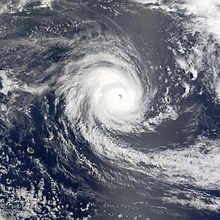
In the Southern Hemisphere basins, January, at the height of the austral summer, is the most active month by cumulative number of storms since records began. Of the four Northern Hemisphere basins, none is very active in January, as the month is during the winter, but the most active basin is the Western Pacific, which occasionally sees weak tropical storms form during the month.[48][38] In 2002, January saw six tropical cyclones form, of which four were named. This does not include the three tropical cyclones that were active when the year began: Tropical Cyclone Bernie in Australia, Tropical Storm Cyprien in Madagascar, and Tropical Depression 05F in the Solomon Islands.[48][38][49] After these storms dissipated, Tropical Storm Tapah formed on 9 January, becoming the first Northern Hemisphere tropical cyclone in 2002.[49] On 16 January, Cyclone Dina formed in the South-West Indian Ocean. Dina would become the only January cyclone to cause significant damage to land, inflicting $287 million in damages and fifteen fatalities in Réunion. The storm was also the most intense of the month, featuring a central pressure of 910 hPa (26.87 inHg).[38]
| Storm name | Dates active | Max wind km/h (mph) | Min pressure (hPa) | Areas affected | Damage (USD) | Deaths | Refs |
|---|---|---|---|---|---|---|---|
| Bernie | 30 December 2001–6 January 2002 | 95 (60) | 980 | Northern Territory | Minimal | None | [48] |
| Cyprien | 30 December 2001–3 January 2002 | 100 (65) | 980 | Madagascar | Minimal | None | [38] |
| 05F | 31 December 2001–6 January 2002 | 65 (40) | 998 | Solomon Islands | None | None | [49][50] |
| Tapah (Agaton) | 9–14 January | 75 (45) | 996 | Philippines | Minimal | None | [51] |
| 06F | 15–16 January | 65 (40) | 1000 | New Caledonia | None | None | [49][50] |
| Dina | 16–25 January | 215 (130) | 910 | Mauritius, Réunion | $287 million | 15 | [38][49][52][53] |
| 07F | 20–27 January | 65 (40) | 997 | Vanuatu, New Caledonia | Minimal | None | [49][50] |
| Eddy | 22–30 January | 130 (80) | 965 | None | None | None | [38] |
| Francesca | 30 January – 11 February | 195 (120) | 925 | None | None | None | [38] |
February
[edit]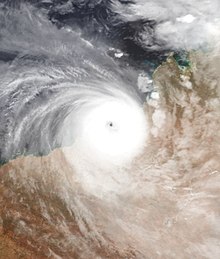
In terms of activity, February is normally similar to January, with activity effectively restricted to the Southern Hemisphere excepting the rare Western Pacific storm. In fact, in the Southern Hemisphere, due to the monsoon being at its height,[48] February tends to see more tropical storm formation than January despite seeing marginally fewer overall storms.[38] The month saw a high number of tropical cyclones – eleven – although most failed to develop past depression intensity, with only four being named.[42] The first storm to form in February, Cyclone Chris, would also become the strongest, with a pressure of 920 hPa (27.17 inHg), and deadliest, causing twelve deaths, of the month. Chris made landfall in Western Australia, causing just short of $1 million in damage. It would become the only hurricane-strength cyclone to make landfall in Australia in 2002.[48] The only other storm forming that month to cause significant damage to land was Typhoon Mitag, which formed on 26 February near the Caroline Islands. Mitag would intensify to become the first super typhoon ever in March,[54] eventually causing $150 million in damage to Micronesia.[55]
| Storm name | Dates active | Max wind km/h (mph) | Min pressure (hPa) | Areas affected | Damage (USD) | Deaths | Refs |
|---|---|---|---|---|---|---|---|
| Chris | 2–7 February | 205 (125) | 915 | Indonesia, Western Australia | $929,000 | 12 | [48][32] |
| 09 | 5–13 February | 45 (30) | 1005 | None | None | None | [56] |
| Monsoon Low | 9–13 February | 55 (35) | 998 | Northern Territory | Unknown | None | [33][57] |
| Claudia | 11–15 February | 130 (80) | 965 | None | None | None | [48][42][57] |
| Guillaume | 14–23 February | 205 (125) | 920 | Mauritius | Minimal | None | [38] |
| TD | 15 February | 55 (35) | 1006 | None | None | None | |
| Monsoon Low | 16–23 February | Unknown | Unknown | Western Australia, Northern Territory | Unknown | None | [33][57] |
| 09F | 17–18 February | 75 (45) | 997 | Fiji | None | None | [42][57] |
| 10F | 23–26 February | 65 (40) | 1000 | None | None | None | [58] |
| 11F | 26–27 February | 30 (15) | 1002 | None | None | None | |
| Mitag (Basyang) | 26 February– 8 March | 175 (110) | 930 | Micronesia | $150 million | 2 | [54][59] |
March
[edit]
During March, activity tends to be lower than in preceding months. In the Southern Hemisphere, the peak of the season has normally already passed, and the monsoon has begun to weaken, decreasing cyclonic activity, however, the month often sees more intense tropical cyclones than January or February.[48][38] Meanwhile, in the Northern Hemisphere basins, sea surface temperatures are still far too low to normally support tropical cyclogenesis. The exception is the Western Pacific, which usually sees its first storm, often a weak depression, at some point between January and April.[55] In 2002, a total of six systems formed during March, of which three intensified into tropical storms.[54] The most intense storm of the month was Cyclone Hary, which formed in the South-West Indian Ocean on 5 March. It intensified to attain a pressure of 905 hPa (26.72 inHg), making Hary the most intense storm thus far in the year, before making landfall in Madagascar, causing four deaths.[38] The only other storm to affect land that month was Tropical Depression 03W, which made landfall in the Philippines, causing $2.4 million in damage and 35 deaths.[54]
| Storm name | Dates active | Max wind km/h (mph) | Min pressure (hPa) | Areas affected | Damage (USD) | Deaths | Refs |
|---|---|---|---|---|---|---|---|
| Des | 3–4 March | 95 (60) | 985 | New Caledonia | None | None | [60][24] |
| Hary | 5–13 March | 220 (140) | 905 | Madagascar, Mauritius, Réunion | Unknown | 4 | [38] |
| 13F | 13–16 March | 65 (40) | 1000 | None | None | None | [26] |
| 14F | 20–23 March | 65 (40) | 1002 | None | None | None | [26] |
| 03W (Caloy) | 21–23 March | 55 (35) | 1004 | Philippines | $2.4 million | 35 | [54] |
| Ikala | 21–29 March | 165 (105) | 945 | None | None | None | [38] |
April
[edit]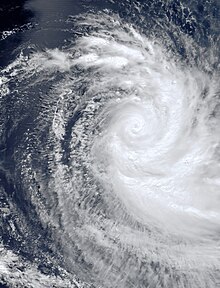
The factors that begin to inhibit Southern Hemisphere cyclone formation in March are even more pronounced in April, with the average number of storms formed being hardly half that of March.[48][34] However, even this limited activity exceeds the activity in the Northern Hemisphere, which is rare, with the exception of the Western Pacific basin. All Pacific typhoon seasons between 1998 and 2016 saw activity between January and April, although many of these seasons saw only weak tropical depressions.[51] By contrast, only two Atlantic hurricane seasons during those years saw tropical cyclone formation during that period.[61] With the combination of the decreasing temperatures in the Southern Hemisphere and the still-low temperatures in the Northern Hemisphere, April and May tend to be the least active months worldwide for tropical cyclone formation.[34] April 2002 was an example of this phenomenon, with only five tropical cyclones forming, and only two becoming tropical storms, making the month the least active of 2022.[34] Of those two storms, the stronger was Tropical Cyclone Dianne–Jery, which formed in the Australian region on 7 April and crossed over to the South-West Indian Ocean before dissipating on 11 April.[38] No storms in April caused any known damage to land.[34]
| Storm name | Dates active | Max wind km/h (mph) | Min pressure (hPa) | Areas affected | Damage (USD) | Deaths | Refs |
|---|---|---|---|---|---|---|---|
| 15F | 1–2 April | Unknown | 1002 | None | None | None | [34] |
| 04W | 6–8 April | 55 (35) | 1004 | None | None | None | [62] |
| Dianne–Jery | 7–11 April | 150 (90) | 955 | None | None | None | [63][64][38][65] |
| Bonnie | 9–14 April | 95 (60) | 985 | Indonesia | None | None | [66] |
| 16F | 17–22 April | Unknown | 1002 | None | None | None | [34] |
May
[edit]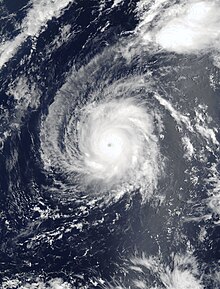
| Storm name | Dates active | Max wind km/h (mph) | Min pressure (hPa) | Areas affected | Damage (USD) | Deaths | Refs |
|---|---|---|---|---|---|---|---|
| Kesiny | 2–11 May | 140 (80) | 965 | Madagascar | Unknown | 33 | [38][67][68][69] |
| ARB 01 | 6–10 May | 65 (40) | 996 | Maldives, Oman | $25 million | 9 | [20][70] |
| Errol | 9–15 May | 65 (40) | 995 | None | None | None | [63] |
| BOB 01 | 10–12 May | 55 (35) | 991 | None | None | None | [20][70][21] |
| Hagibis | 15–21 May | 175 (110) | 935 | Caroline Islands, Mariana Islands | None | None | [71][72] |
| Unnumbered | 17–19 May | 55 (35) | 995 | None | None | None | [22] |
| Alma | 24 May – 1 June | 185 (115) | 960 | None | None | None | [73] |
| Upia | 26–29 May | 75 (45) | 990 | Budibudi Island, Papua New Guinea | None | None | [74] |
| 06W (Dagul) | 26–30 May | 55 (35) | 1002 | Philippines, Taiwan | None | None | [62][75] |
| TD | 27–29 May | Unknown | 1008 | None | None | None |
June
[edit]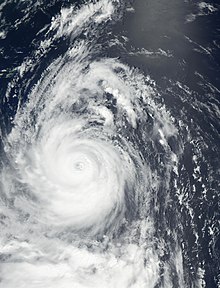
| Storm name | Dates active | Max wind km/h (mph) | Min pressure (hPa) | Areas affected | Damage (USD) | Deaths | Refs |
|---|---|---|---|---|---|---|---|
| TD | 3–5 June | Unknown | 1004 | Ryukyu Islands | None | None | |
| Noguri (Espada) | 4–7 June | 100 (65) | 980 | China | $500 million | 153 | [12][62][76] |
| Boris | 8–11 June | 95 (60) | 997 | Southwestern Mexico | Minimal | None | [77][78] |
| 15 | 13–15 June | 45 (30) | 1000 | None | None | None | [38][79] |
| Three-E | 27–29 June | 55 (35) | 1006 | None | None | None | [80][81] |
| Rammasun (Florita) | 28 June – 1 July | 155 (100) | 945 | China, Korean Peninsula, Ryukyu Islands, Taiwan | $100 million | 97 | [15][82][83][62] |
| Chataan (Gloria) | 28 June – 11 July | 175 (110) | 930 | Chuuk, Guam, Japan | $660 million | 54 | [12][84][85] |
July
[edit]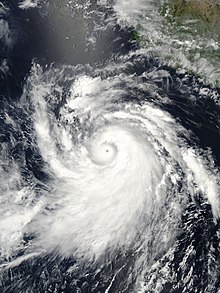
| Storm name | Dates active | Max wind km/h (mph) | Min pressure (hPa) | Areas affected | Damage (USD) | Deaths | Refs |
|---|---|---|---|---|---|---|---|
| 17F | 3–5 July | 45 (30) | 999 | None | None | None | [13][86] |
| Halong (Inday) | 6–16 July | 155 (100) | 945 | Guam, Philippines, Japan | $89.8 million | 10 | [12][62][87][88][89] |
| Nakri (Hambalos) | 7–13 July | 95 (60) | 983 | Philippines, China, Taiwan, Japan | None | 2 | [12][90][91] |
| Cristina | 9–16 July | 100 (65) | 994 | None | None | None | [92] |
| Fengshen | 13–28 July | 185 (115) | 920 | Japan, China | $4 million | 5 | [12][62][93][94] |
| Arthur | 14–16 July | 95 (60) | 997 | Southeastern United States | Minimal | 1 | [95][96][97] |
| 13W (Juan) | 18–23 July | 55 (35) | 1002 | Philippines | $240 thousand | 14 | [62][98] |
| Fung-wong (Kaka) | 18–27 July | 130 (80) | 960 | Japan | None | None | [12][62][99][100] |
| Douglas | 20–26 July | 165 (105) | 970 | None | None | None | [101] |
| Kalmaegi | 20–21 July | 65 (40) | 1003 | None | None | None | [12][62] |
| Elida | 23–30 July | 260 (160) | 921 | None | None | None | [102] |
| TD | 25–26 July | Unknown | 1004 | None | None | None | |
| TD | 29–30 July | Unknown | 998 | South China | None | None |
August
[edit]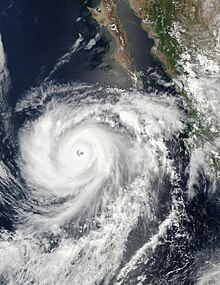
| Storm name | Dates active | Max wind km/h (mph) | Min pressure (hPa) | Areas affected | Damage (USD) | Deaths | Refs |
|---|---|---|---|---|---|---|---|
| Kammuri (Lagalag) | 2–7 August | 100 (65) | 980 | China | $509 million | 153 | [103][12][18] |
| Bertha | 4–9 August | 65 (40) | 1007 | Mississippi | $200 thousand | 1 | [104][105] |
| 17W | 5–6 August | 55 (35) | 998 | None | None | None | [62][19] |
| Cristobal | 5–8 August | 85 (50) | 999 | Bermuda, New York | Minimal | 3 | [106][107] |
| Seven-E | 6–8 August | 55 (35) | 1008 | None | None | None | [108][109] |
| 18W (Milenyo) | 11–14 August | 55 (35) | 998 | Philippines | $3.3 million | 35 | [62][110] |
| Phanfone | 11–20 August | 155 (100) | 940 | Japan | None | None | [12][62][111][112] |
| Vongfong | 15–20 August | 75 (45) | 985 | China | $86 million | 9 | [12][113] |
| Fausto | 21 August – 3 September | 230 (145) | 936 | Aleutian Islands, British Columbia | None | None | [114][115] |
| Alika | 22–28 August | 100 (65) | 995 | None | None | None | [115] |
| Rusa | 22 August – 1 September | 150 (90) | 950 | Japan, South Korea, North Korea | $4.2 billion | 238 | [116][117][118][119] |
| Genevieve | 26 August – 1 September | 110 (70) | 989 | None | None | None | [120] |
| Sinlaku | 27 August – 9 September | 150 (90) | 950 | Japan, China | $723 million | 30 | [12][62][121] |
| Ele | 27 August – 10 September | 205 (125) | 945 | Johnston Atoll, Wake Island | None | None | [115][12][62] |
| Dolly | 29 August – 4 September | 95 (60) | 997 | None | None | None | [122][123][124] |
| Hernan | 30 August – 6 September | 260 (160) | 921 | Southwestern Mexico, Revillagigedo Islands, Socorro Island, Southwestern United States | None | None | [125][126] |
September
[edit]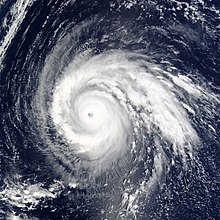
| Storm name | Dates active | Max wind km/h (mph) | Min pressure (hPa) | Areas affected | Damage (USD) | Deaths | Refs |
|---|---|---|---|---|---|---|---|
| Edouard | 1–6 September | 100 (65) | 1002 | Florida | Minimal | None | [127] |
| Fay | 5–8 September | 95 (60) | 998 | Texas, Mexico | $4.5 million | None | [128][129] |
| 01 | 5–8 September | 65 (40) | 1003 | Seychelles | $50 thousand | None | [130][131][132] |
| Eleven-E | 5–8 September | 55 (35) | 1006 | Baja California Peninsula | Minimal | None | [133] |
| Seven | 7–8 September | 55 (35) | 1013 | None | None | None | [134] |
| Gustav | 8–12 September | 155 (100) | 960 | North Carolina, Virginia, New Jersey, New England | $340 thousand | 4 | [135][136][137] |
| Hagupit | 9–15 September | 85 (50) | 990 | China | $32.5 million | 25 | [12][62][138] |
| Hanna | 12–15 September | 95 (60) | 1001 | Florida, Louisiana, Alabama, Mississippi, Georgia, Southeastern U.S., Mid-Atlantic states | $20 million | 3 | [139][140][141] |
| Isidore | 14–27 September | 205 (125) | 934 | Venezuela, Jamaica, Cayman Islands, Cuba, Yucatán Peninsula, Louisiana, Mississippi | $1.28 billion | 22 | [142][143][144] |
| Iselle | 15–20 September | 110 (70) | 990 | Baja California Peninsula | Minimal | None | [145][146] |
| Josephine | 17–19 September | 65 (40) | 1006 | None | None | None | [147] |
| TD | 18–19 September | Unknown | 1002 | Mariana Islands | None | None | |
| Kyle | 20 September – 12 October | 140 (85) | 980 | Bermuda, Florida, Georgia, South Carolina, North Carolina, British Isles | $5 million | 1 | [148][149][150] |
| Lili | 21 September – 4 October | 230 (145) | 938 | Windward Islands, Haiti, Cuba, Cayman Islands, Louisiana | $1.16 billion | 15 | [151][152] |
| TD | 21–22 September | Unknown | 1008 | None | None | None | [12] |
| Mekkhala | 22–28 September | 85 (50) | 990 | China | $103 million | None | [12][62][153] |
| Julio | 25–26 September | 75 (45) | 1000 | Southwestern Mexico | Minimal | 3 | [154][155] |
| Higos | 26 September – 2 October | 175 (110) | 930 | Japan, Primorsky Krai | $2.14 billion | 12 | [156][157][158] |
October
[edit]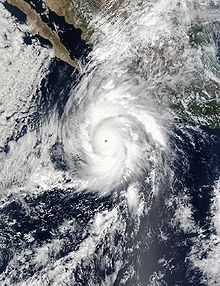
| Storm name | Dates active | Max wind km/h (mph) | Min pressure (hPa) | Areas affected | Damage (USD) | Deaths | Refs |
|---|---|---|---|---|---|---|---|
| Bavi | 8–13 October | 100 (65) | 985 | None | None | None | [12] |
| TD | 12 October | Unknown | 1004 | None | None | None | [12][62] |
| Fourteen | 14–16 October | 55 (35) | 1002 | Jamaica, Cayman Islands, Cuba | Minimal | None | [159] |
| 27W | 15–18 October | 55 (35) | 1004 | None | None | None | [12][62] |
| 28W | 18–19 October | 55 (35) | 1008 | None | None | None | [12][62] |
| 01F | 21–22 October | 45 (30) | 1002 | None | None | None | [160][161] |
| Kenna | 22–26 October | 270 (165) | 913 | Southwestern Mexico, Western Mexico, Southern United States, Revillagigedo Islands, Socorro Island, Texas | $101 million | 4 | [162][163][164] |
| BOB 02 | 22–25 October | 45 (30) | 1003 | None | None | None | [165] |
| Lowell | 22–31 October | 85 (50) | 1002 | Hawaii | None | None | [166] |
| TD | 23–24 October | Unknown | 1010 | Taiwan | None | None | |
| Huko | 24 October – 7 November | 140 (85) | 985 | None | None | None | [167] |
| Maysak | 26–31 October | 100 (65) | 980 | None | None | None | [168] |
November
[edit]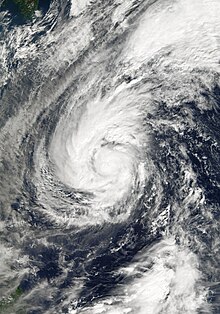
| Storm name | Dates active | Max wind km/h (mph) | Min pressure (hPa) | Areas affected | Damage (USD) | Deaths | Refs |
|---|---|---|---|---|---|---|---|
| Atang | 4–13 November | 55 (35) | 997 | Madagascar, Mozambique, Tanzania | None | None | [169][170][171] |
| BOB 03 | 10–12 November | 100 (65) | 984 | Bangladesh, India | None | 173 | [172][46][20] |
| Sixteen-E | 14–16 November | 55 (35) | 1006 | None | None | None | [173][174] |
| Boura | 14–27 November | 130 (80) | 965 | None | None | None | [175] |
| Haishen | 20–25 November | 155 (100) | 955 | None | None | None | [12][62] |
| BOB 04 | 23–28 November | 85 (50) | 991 | None | None | None | [20] |
| TD | 27 November | Unknown | 1008 | None | None | None | [12][62] |
| Yolande | 29 November – 6 December | 65 (40) | 995 | Tonga | None | None | [28] |
December
[edit]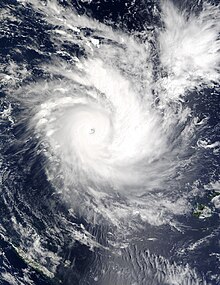
| Storm name | Dates active | Max wind km/h (mph) |
Pressure (hPa) |
Areas affected | Damage (USD) |
Deaths | Refs |
|---|---|---|---|---|---|---|---|
| Pongsona | 2–11 December | 165 (105) | 940 | Guam, Northern Mariana Islands | $730 million | 1 | [176][177][178] |
| 03F | 10–13 December | 55 (35) | 1002 | None | None | None | [28][86] |
| Crystal | 21–29 December | 150 (90) | 955 | Mauritius | Minimal | None | [179] |
| BOB 05 | 21–25 December | 65 (40) | 997 | None | None | None | [20] |
| Zoe | 23 December 2002–4 January 2003 | 240 (150) | 890 | Solomon Islands, Vanuatu, Fiji | Severe | None | [28][180][181] |
| Delfina | 30 December 2002–9 January 2003 | 95 (60) | 984 | Mozambique, Malawi | $3.5 million | 54 | [182][183][184] |
Global effects
[edit]See also
[edit]Notes
[edit]- ^ a b The wind speeds for this tropical cyclone/basin are based on the Saffir Simpson Scale which uses 1-minute sustained winds.
- ^ a b The number in the bracket indicates indirect deaths.
- ^ a b c d Only systems that formed either before or on December 31, 2002 are counted in the seasonal totals.
- ^ According to the JMA, Hurricanes Ele and Huko entered the West Pacific Basin and became Typhoons Ele and Huko between August 30 and November 3
- ^ The wind speeds for this tropical cyclone/basin are based on the IMD Scale which uses 3-minute sustained winds.
- ^ a b c Only systems that formed either on or after January 1, 2002 are counted in the seasonal totals.
- ^ The wind speeds for this tropical cyclone are based on Météo-France, which uses wind gusts.
- ^ The sum of the number of systems in each basin will not equal the number shown as the total. This is because when systems move between basins, it creates a discrepancy in the actual number of systems.
- ^ A super typhoon is an unofficial category used by the Joint Typhoon Warning Center (JTWC) for a typhoon with winds of at least 240 km/h (150 mph).[11]
- ^ All damage totals are valued as of 2002 and in United States dollars, unless otherwise noted.
- ^ a b The total was originally reported in Philippine pesos. Total converted via the Oanda Corporation website.[16]
- ^ a b The total was originally reported in Chinese renminbi. Total converted via the Oanda Corporation website.[16]
References
[edit]- ^ "Historical El Niño/La Niña episodes (1950–present)". United States Climate Prediction Center. 1 February 2019. Retrieved 15 March 2019.
- ^ "El Niño – Detailed Australian Analysis". Australian Bureau of Meteorology. Retrieved 3 April 2016.
- ^ Trenberth, K.E.; P.D. Jones; P. Ambenje; R. Bojariu; D. Easterling; A. Klein Tank; D. Parker; F. Rahimzadeh; J.A. Renwick; M. Rusticucci; B. Soden; P. Zhai. "Observations: Surface and Atmospheric Climate Change". In Solomon, S.; D. Qin; M. Manning; et al. (eds.). Climate Change 2007: The Physical Science Basis. Contribution of Working Group I to the Fourth Assessment Report of the Intergovernmental Panel on Climate Change. Cambridge, UK: Cambridge University Press. pp. 235–336. Archived from the original on 2017-09-24. Retrieved 2014-06-30.
- ^ a b Landsea, Christopher W; Dorst, Neal M (1 June 2014). "Subject: G2) How does El Niño-Southern Oscillation affect tropical cyclone activity around the globe?". Tropical Cyclone Frequently Asked Question. United States National Oceanic and Atmospheric Administration's Hurricane Research Division. Archived from the original on 9 October 2014.
- ^ "What is El Niño and what might it mean for Australia?". Australian Bureau of Meteorology. Archived from the original on 18 March 2016. Retrieved 10 April 2016.
- ^ Gerald Bell; Eric Blake; Muthuvel Chelliah; Stanley Goldenberg; Chris Landsea; Richard Pasch. "The 2002 North Atlantic Hurricane Season" (PDF). Climate Prediction Center. Archived (PDF) from the original on September 24, 2008. Retrieved September 16, 2008.
- ^ Franklin, Avila; Beven; Lawrence; Pasch & Stewart (November 30, 2002). "Monthly Tropical Weather Summary". National Hurricane Center. Archived from the original on September 22, 2008. Retrieved September 16, 2008.
- ^ "Verification of Forecasts of Tropical Cyclone Activity over the Western North Pacific in 2002". Laboratory for Atmospheric Research at the City University of Hong Kong. 2003-01-15. Archived from the original on May 30, 2009. Retrieved 2012-10-28.
- ^ a b c Gary Padgett. Monthly Global Tropical Cyclone Summary December 2002 (Report). Australian Severe Weather. Retrieved 30 October 2013.
- ^ RSMC Nadi — Tropical Cyclone Centre (August 29, 2007). Tropical Cyclone Seasonal Summary 2002–2003 season (PDF) (Report). Fiji Meteorological Service. Archived from the original (PDF) on October 1, 2008. Retrieved October 13, 2012.
- ^ Frequently Asked Questions (Report). Joint Typhoon Warning Center. 2012-08-13. Archived from the original on 2013-10-04. Retrieved 2012-09-22.
- ^ a b c d e f g h i j k l m n o p q r s t u v w x Annual Report on Activities of the RSMC Tokyo – Typhoon Center 2002 (PDF) (Report). Japan Meteorological Agency. 8. Archived from the original (PDF) on 2013-10-14. Retrieved 2012-07-24.
- ^ a b Padgett, Gary. "Monthly Global Tropical Cyclone Summary: July 2002". Retrieved April 22, 2012.
- ^ Danielito T. Franco. Philippine Water Resource Systems and Water Related Disasters (PDF) (Report). Agricultural and Forestry Research Center, University of Tsukuba. pp. 58–59. Archived (PDF) from the original on 2004-03-22. Retrieved 2012-10-12.
- ^ a b Climatology and Agrometeorology Branch (2006-11-11). "Tropical Cyclone Track: Typhoon Florita". Philippine Atmospheric, Geophysical and Astronomical Services Administration. Archived from the original on 2003-08-27. Retrieved 2012-10-28.
- ^ a b "Historical Exchange Rates". Oanda Corporation. 2012. Archived from the original on 2013-10-04. Retrieved 2012-09-24.
- ^ China: Flash Floods Appeal No. 16/02 Operations Update No. 5 (Report). ReliefWeb. 2002-12-31. Archived from the original on 2014-08-08. Retrieved 2012-10-15.
{{cite report}}: Unknown parameter|agency=ignored (help) - ^ a b International Federation of Red Cross and Red Crescent Societies (2002-09-03). China: Flash Floods Appeal No. 16/02 Operations Update No. 4 (Report). ReliefWeb. Archived from the original on 2014-08-08. Retrieved 2012-10-15.
- ^ a b Gary Padgett (2002). "Monthly Global Tropical Cyclone Summary August 2002". Archived from the original on 2011-09-27. Retrieved 2012-09-01.
- ^ a b c d e f g h i j k l m Best Tracks Data: 2002 (Report). India Meteorological Department. 2003. Archived from the original on 16 November 2009. Retrieved 23 December 2013.
- ^ a b Gary Padgett. Monthly Global Tropical Cyclone Summary – May 2002 (Report). Retrieved March 26, 2013.
- ^ a b c d Gary Padgett (August 1, 2002). Global Tropical Cyclone Tracks – May 2002 (Report). Retrieved September 30, 2012.
- ^ S.K. Dash; Jenamani Rajendra Kumar; M. S. Shekhar (May 2004). "On the decreasing frequency of monsoon depressions over the Indian region" (PDF). Current Science. 86 (10): 1404. Retrieved 2014-01-07.
- ^ a b c d e Jonty D. Hall (December 4, 2004). "The South Pacific and southeast Indian Ocean tropical cyclone season 2001-02" (PDF). Australian Meteorology Magazine. 53 (4). Queensland Regional Office, Bureau of Meteorology, Australia: 285–304. Archived from the original (PDF) on July 6, 2011. Retrieved December 5, 2010.
- ^ "Severe Tropical Cyclone Claudia". Australian Bureau of Meteorology. 2010. Retrieved December 7, 2010.
- ^ a b c d e Gary Padgett (December 27, 2006). "Monthly Tropical Weather Summary for March 2002". Australia Severe Weather. Retrieved June 10, 2012.
- ^ "Tropical Cyclone Operation Plan for the South Pacific and South-East Indian Ocean" (PDF). World Meteorological Organization. 2006. Archived from the original (PDF) on March 1, 2005. Retrieved December 7, 2010.
- ^ a b c d e f RSMC Nadi — Tropical Cyclone Centre (August 29, 2007). Tropical Cyclone Seasonal Summary 2002–2003 season (PDF) (Report). Fiji Meteorological Service. Archived from the original (PDF) on October 1, 2008. Retrieved October 13, 2012.
- ^ Courtney, Joe B (June 2, 2005). "The South Pacific and southeast Indian Ocean tropical cyclone season 2002–03" (PDF). Australian Meteorology Magazine. 54. Australian Bureau of Meteorology: 137–150. Archived from the original (PDF) on March 14, 2012. Retrieved October 13, 2012.
- ^ a b "SIGNIFICANT WEATHER - January 2002". Bureau of Meteorology (Australia). Retrieved 22 May 2007.
- ^ a b Joe Courtney (2002). "Tropical Cyclone Chris Tropical Cyclone Report" (PDF). Perth Tropical Cyclone Warning Centre. Australian Bureau of Meteorology. Retrieved 10 December 2010.
- ^ a b "Cyclone Chris batters remote coast of northwest Australia". Associated Press Worldstream. 6 February 2002. Archived from the original on 4 November 2012. Retrieved 23 July 2010.
- ^ a b c d Gary Padgett (27 December 2006). "Monthly Global Tropical Cyclone Summary February 2002". Australian Severe Weather. Retrieved 9 December 2019.
- ^ a b c d e f g h i Gary Padgett (December 27, 2006). "Monthly Tropical Weather Summary for April 2002". Australia Severe Weather. Retrieved June 10, 2012.
- ^ a b c d "WA Tropical Cyclone Season Summary 2001–02". Bureau of Meteorology (Australia). Retrieved 25 May 2007.
- ^ "Climate of 2002 - April - Global Regional Analysis: Australia and Indonesia". National Climatic Data Center. Retrieved 11 May 2008.
- ^ Tropical Cyclone 07S Best Track Analysis. Joint Typhoon Warning Center (Report). United States Navy. 2003. Retrieved 28 November 2013.
- ^ a b c d e f g h i j k l m n o p q r s t u v w x y Cyclone Season 2001–2002. RSMC La Réunion (Report). Météo-France. Archived from the original on October 18, 2014. Retrieved 2012-11-26.
- ^ "Tropical Cyclone CYPRIEN : JTWC Advisories". United States Joint Typhoon Warning Center. Australian Severe Weather. Archived from the original on November 1, 2013. Retrieved 5 September 2021.
- ^ "Cyclone Dina wreaks havoc on Reunion". Saint-Denis, Réunion: Pan African News Agency. 2002-01-23. Archived from the original on October 29, 2014. Retrieved 5 September 2021.
- ^ "Tropical Cyclone Eddy track". RSMC La Reunion. Archived from the original on October 31, 2013. Retrieved 2021-12-12.
- ^ a b c d Gary Padgett (2006-12-27). "Global Tropical Cyclone Summary for February 2002". Monthly Global Tropical Cyclone Summary. Australian Severe Weather. Archived from the original on December 23, 2014. Retrieved 2012-11-26.
- ^ (in French) Track for Intense Tropical Cyclone Guillame. RSMC La Reunion (Report). Météo-France. Archived from the original on December 23, 2014. Retrieved 2021-12-30.
- ^ Mannava V.K. Sivakumar; Raymond P. Motha; Haripada P. Das (2005). Natural Disasters and Extreme Events in Agriculture: Impacts and Mitigation. The Netherlands: Springer. p. 13. ISBN 3-540-22490-4. Retrieved January 27, 2025.
- ^ Boyle, Kevin. "Monthly Global Tropical Cyclone Summary September 2002". Padgett, Gary. Retrieved January 25, 2025.
- ^ a b c Padgett, Gary. "Monthly Global Tropical Cyclone Summary – November 2002". Retrieved January 25, 2025.
- ^ "Cyclone claims 11 lives in Mozambique". ReliefWeb. Reuters. 2003-03-07. Retrieved 2012-12-05.
- ^ a b c d e f g h i "Australian Tropical Cyclone Database" (CSV). Bureau of Meteorology. 1 December 2019. Retrieved 1 December 2019.
- ^ a b c d e f Gary Padgett (27 December 2006). "Monthly Global Tropical Cyclone Summary January 2002". Australian Severe Weather. Retrieved 21 October 2012.
- ^ a b c Gary Padgett (27 December 2006). "Monthly Global Tropical Cyclone Tracks January 2002". Australian Severe Weather. Retrieved 1 December 2019.
- ^ a b "RSMC Best Track Data (Text) 1951-2019". Japan Meteorological Agency. Retrieved 1 December 2019.
- ^ "Cyclone takes heavy toll in Mauritius". Pan African News Agency. ReliefWeb. 25 January 2002. Retrieved 22 October 2012.
- ^ "Synthèse Des Événements : Dina, cyclone tropical intense (22 et 23 janvier 2002)" (PDF) (in French). Risques Naturales. 2010. Retrieved 21 October 2012.
- ^ a b c d e Gary Padgett (2002). "Monthly Global Tropical Cyclone Summary, March 2002". Archived from the original on 2011-09-01. Retrieved 2012-08-06.
- ^ a b Cite error: The named reference
JMABTwas invoked but never defined (see the help page). - ^ Gary Padgett (2006-12-27). "February, 2002". Monthly Global Tropical Cyclone Summary. Australian Severe Weather. Archived from the original on December 23, 2014. Retrieved 2012-11-26.
- ^ a b c d Gary Padgett (27 December 2006). "Monthly Global Tropical Cyclone Tracks February 2002". Australian Severe Weather. Retrieved 9 December 2019.
- ^ "Tropical Cyclone 16P Best Track". Joint Typhoon Warning Center. United States Navy. 2003. Archived from the original (.TXT) on September 17, 2012. Retrieved June 10, 2012.
- ^ "Storm Data and Unusual Weather Phenomena with Late Reports and Corrections" (PDF). Storm Data. 44 (3). National Oceanic and Atmospheric Administration: 134–136. March 2002. Archived from the original (PDF) on 2014-07-30. Retrieved 2012-08-07.
- ^ MetService (May 22, 2009). "TCWC Wellington Best Track Data 1967–2006". International Best Track Archive for Climate Stewardship.[permanent dead link]
- ^ "Atlantic hurricane best track (HURDAT version 2)" (Database). United States National Hurricane Center. May 11, 2024. Retrieved February 7, 2025.
 This article incorporates text from this source, which is in the public domain.
This article incorporates text from this source, which is in the public domain.
- Landsea, Chris (April 2022). "The revised Atlantic hurricane database (HURDAT2) - Chris Landsea – April 2022" (PDF). Hurricane Research Division – NOAA/AOML. Miami: Hurricane Research Division – via Atlantic Oceanographic and Meteorological Laboratory.
- ^ a b c d e f g h i j k l m n o p q r s t u Joint Typhoon Warning Center. Annual Tropical Cyclone Report (PDF) (Report). United States Navy. Archived (PDF) from the original on 2013-02-21. Retrieved 2012-07-25.
- ^ a b "WA Tropical Cyclone Season Summary 2001–02". Bureau of Meteorology (Australia). Retrieved 25 May 2007.
- ^ Gary Padgett (2002). "Monthly Global Tropical Cyclone Summary April 2002". Retrieved 3 May 2008.
- ^ Gary Padgett (2006-12-27). "April, 2002". Monthly Global Tropical Cyclone Summary. Australian Severe Weather. Archived from the original on December 3, 2013. Retrieved 2012-11-24.
- ^ "Climate of 2002 - April - Global Regional Analysis: Australia and Indonesia". National Climatic Data Center. Retrieved 11 May 2008.
- ^ Mannava V.K. Sivakumar; Raymond P. Motha; Haripada P. Das (2005). Natural Disasters and Extreme Events in Agriculture: Impacts and Mitigation. The Netherlands: Springer. p. 13. ISBN 3-540-22490-4. Retrieved 2012-11-20.
- ^ "Two dead in Madagascar flooding". Agence France-Presse. ReliefWeb. 2002-05-11. Archived from the original on February 23, 2015. Retrieved 2012-11-19.
- ^ Embassy Rome (October 22, 2002). Madagascar After The Political Crisis: Averting A Humanitarian Crisis (Report). WikiLeaks. Archived from the original on June 15, 2013. Retrieved November 20, 2012.
- ^ a b R. R. KelKar (2004). Panel On Tropical Cyclones Annual Review 2002 (PDF) (Report). World Meteorological Organization. pp. 58, 60. Retrieved March 26, 2013.
- ^ Gary Padgett (2002). "Monthly Global Tropical Cyclone Summary May 2002". Archived from the original on 2014-01-07. Retrieved 2012-09-28.
- ^ Rebecca Schneider. Pacific ENSO Update 3rd Quarter 2002-Vol. 8 No. 3. National Oceanic and Atmospheric Administration Office of Global Program (Report). Pacific Climate Information System. Archived from the original on 2014-08-11. Retrieved 2012-09-28.
- ^ Stacy Stewart (July 24, 2002). "Tropical Cyclone Report Hurricane Alma". National Hurricane Center. Archived from the original on September 22, 2008. Retrieved September 13, 2008.
- ^ "Regional Association V Tropical Cyclone Committee for the South Pacific and South-East Indian Ocean" (PDF). World Meteorological Organization. 2004. pp. 53–54. Retrieved 17 May 2008.
- ^ Tropical Depression 06W Warning NR 001 (Report). Joint Typhoon Warning Center. Archived from the original on 2018-09-21. Retrieved 2012-09-28.
- ^ Weather Disaster Report (2002-927-02) (Report). Digital Typhoon. Archived from the original on 2018-09-21. Retrieved 2012-10-12.
- ^ James Franklin (June 24, 2002). "Tropical Cyclone Report Tropical Storm Boris". National Hurricane Center. Archived from the original on September 22, 2008. Retrieved September 13, 2008.
- ^ David M. Roth. "Tropical Storm Boris — June 5–12, 2002" (GIF). Hydrometeorological Prediction Center. Archived from the original on October 19, 2008. Retrieved September 13, 2008.
- ^ (in French) Track for Tropical Disturbance 15 (Report). Météo-France. Archived from the original on May 19, 2011. Retrieved 2012-11-26.
- ^ Lixion Avila (July 6, 2002). "Tropical Depression Report Tropical Depression Three-E". National Hurricane Center. Archived from the original on September 22, 2008. Retrieved September 13, 2008.
- ^ Lawrence (June 27, 2002). "Tropical Depression Three-E Discussion Number 1". National Hurricane Center. Archived from the original on October 21, 2008. Retrieved September 13, 2008.
- ^ Weather Disaster Report (2002-936-04) (Report). Digital Typhoon. Retrieved 2012-10-04.
- ^ Weather Disaster Report (2002-927-03) (Report). Digital Typhoon. Archived from the original on 2018-09-21. Retrieved 2012-10-04.
- ^ Charles Guard; Mark A. Lander; Bill Ward (2007). A Preliminary Assessment of the Landfall of Typhoon Chataan on Chuuk, Guam, and Rota (Report). World Meteorological Organization. Archived from the original on 2015-03-31. Retrieved 2012-06-20. Alt URL
- ^ Angel, William; Hinson, Stuart; Mooring, Rhonda (November 2002). Storm Data and Unusual Weather Phenomena with Late Reports and Corrections (PDF). Storm Data (Report). Vol. 44. National Climatic Data Center. pp. 142, 145–149. Archived from the original (PDF) on 2012-08-12.
- ^ a b RSMC Nadi — Tropical Cyclone Centre. "Tropical Disturbance Summary July 3, 2002 21z". Fiji Meteorological Service. Retrieved April 22, 2012.
- ^ Theresa Merto (2002-07-12). "Guam Power Authority Lines up Priorities, Crews Work to Connect Shelters, 911 Center". ReliefWeb. Pacific Daily News. Archived from the original on 2012-10-12. Retrieved 2012-10-09.
- ^ Weather Disaster Report (2002-582-01) (Report). Digital Typhoon. Archived from the original on 2018-09-21. Retrieved 2012-10-09.
- ^ Weather Disaster Report (2002-604-16) (Report). Digital Typhoon. Archived from the original on 2018-09-21. Retrieved 2012-10-09.
- ^ Weather Disaster Report (2002-605-15) (Report). Digital Typhoon. Archived from the original on 2018-09-21. Retrieved 2012-10-12.
- ^ "Storm leaves two dead, one missing in Taiwan". Agence France-Presse. 2002-07-10 – via Lexis Nexis.
- ^ Miles Lawrence; Eric Blake (November 30, 2002). "Tropical Cyclone Report Tropical Storm Cristina". National Hurricane Center. Archived from the original on September 22, 2008. Retrieved September 13, 2008.
- ^ Typhoon 200209 (Fengshen) – Disaster Information (Report). Digital Typhoon. Archived from the original on 2018-09-21. Retrieved 2012-09-18.
- ^ "Four die as ship founders". The Daily Telegraph. 2002-07-29 – via Lexis Nexis.
- ^ Miles Lawrence (August 20, 2002). "Tropical Storm Arthur Tropical Cyclone Report". National Hurricane Center. Archived from the original on July 26, 2008. Retrieved 2008-08-01.
- ^ Roth, David (December 3, 2002). "Tropical Storm Arthur – July 9–15, 2002". Hydrometeorological Prediction Center. Archived from the original on December 5, 2010. Retrieved 2010-11-28.
- ^ Peter Bowyer (2003). "A Climatology of Hurricanes for Canada: Improving Our Awareness of the Threat". Canadian Hurricane Centre. Archived from the original on February 6, 2009. Retrieved 2008-01-07.
- ^ Felix De Los Santos (2002-07-23). "Typhoon 'Kaka' Approaches as 'Juan' Lingers". Philippine Headline News Online. Archived from the original on 2005-02-20. Retrieved 2012-10-12.
- ^ Typhoon 200211 (Fung-Wong) – Disaster Information (Report). Digital Typhoon. Retrieved 2012-10-15.
- ^ Weather Disaster Report (2002-815-05) (Report). Digital Typhoon. Archived from the original on 2018-09-21. Retrieved 2012-10-15.
- ^ Richard Pasch (December 13, 2002). "Tropical Cyclone Report Hurricane Douglas". National Hurricane Center. Archived from the original on September 22, 2008. Retrieved September 13, 2008.
- ^ Jack Beven (December 13, 2002). "Tropical Cyclone Report Hurricane Elida". National Hurricane Center. Archived from the original on September 22, 2008. Retrieved September 13, 2008.
- ^ Damage Caused by Tropical Cyclones in Hong Kong in 2002 (Report). Hong Kong Observatory. Archived from the original on 2014-08-10. Retrieved 2012-10-14.
- ^ Beven, Jack (November 20, 2002). "Tropical Storm Bertha Tropical Cyclone Report". National Hurricane Center. Archived from the original on 2010-09-04. Retrieved 2010-11-28.
- ^ "Damage report on Bertha" (PDF). Louisiana State University. 2002. Retrieved 2010-11-28.
- ^ Franklin, James (August 22, 2002). "Tropical Storm Cristobal Tropical Cyclone Report". National Hurricane Center. Archived from the original on 2010-09-04. Retrieved 2010-11-28.
- ^ "Damage Report on Cristobal" (PDF). Louisiana State University. 2002. Retrieved 2010-11-28.
- ^ Jack Beven (November 20, 2002). "Tropical Cyclone Report Tropical Depression Seven-E". National Hurricane Center. Archived from the original on September 22, 2008. Retrieved September 13, 2008.
- ^ Franklin (August 6, 2002). "Tropical Depression Seven-E Discussion 1". National Hurricane Center. Archived from the original on October 21, 2008. Retrieved September 13, 2008.
- ^ "Tropical depression drifts away from Philippine territory after killing at least 16 people". Associated Press. 2002-08-13 – via Lexis Nexis.
- ^ Typhoon 200213 (Phanfone) – Disaster Information (Report). Digital Typhoon. Archived from the original on 2018-09-21. Retrieved 2012-10-15.
- ^ "Earthweek: A Diary of the Planet". Vancouver Sun. 2002-08-24 – via Lexis Nexis.
- ^ Clifford Lo (2002-08-20). "Motorcycle rider killed as storm skirts SAR". South China Morning Post (Hong Kong) – via Lexis Nexis.
- ^ James Franklin (December 6, 2002). "Tropical Cyclone Report Hurricane Fausto". National Hurricane Center. Archived from the original on September 22, 2008. Retrieved September 13, 2008.
- ^ a b c Andy Nash; Hans Rosendal; Brooke Bingaman; Treena Loos; Jeff Fournier. "2002 Central North Pacific Tropical Cyclones". Central Pacific Hurricane Center. Archived from the original on September 28, 2008. Retrieved August 26, 2008.
- ^ N. W. Kim; Y. S. Won; I. M. Chung (2006-10-09). "The scale of typhoon Rusa" (PDF). Hydrology and Earth System Sciences Discussions. 3 (5): 3148–3157. Bibcode:2006HESSD...3.3147K. doi:10.5194/hessd-3-3147-2006. Archived (PDF) from the original on 2013-09-27. Retrieved 2012-07-24.
- ^ "Typhoon Rusa (South Korea) situation report 04 Sept 2002". ReliefWeb. Church World Service. 2002-09-04. Archived from the original on 2014-08-08. Retrieved 2012-07-31.
- ^ International Federation of Red Cross and Red Crescent Societies (2002-09-09). DPR Korea: Typhoon Rusa Information Bulletin No. 2/2002 (Report). ReliefWeb. Archived from the original on 2014-08-08. Retrieved 2012-07-31.
- ^ "Thousands homeless in North Korea from typhoon: aid agencies". ReliefWeb. Agence France-Presse. 2002-09-04. Archived from the original on 2014-08-08. Retrieved 2012-07-31.
- ^ Lixion Avila (October 12, 2002). "Tropical Cyclone Report Tropical Storm Genevieve". National Hurricane Center. Archived from the original on September 22, 2008. Retrieved September 13, 2008.
- ^ Guy Carpenter (2003-01-30). Tropical Cyclone Review 2002 (PDF) (Report). Marsh & McLennan Companies. p. 21. Archived from the original (PDF) on 2012-02-06. Retrieved 2012-07-25.
- ^ Lixion A. Avila (October 12, 2002). "Tropical Storm Dolly Tropical Cyclone Report". National Hurricane Center. Archived from the original on September 13, 2008. Retrieved 2008-09-07.
- ^ Lixion A. Avila (August 29, 2002). "Tropical Depression Four Discussion One". National Hurricane Center. Archived from the original on October 20, 2008. Retrieved 2008-09-07.
- ^ Lixion A. Avila (August 29, 2002). "Tropical Storm Dolly Discussion Two". National Hurricane Center. Archived from the original on October 4, 2008. Retrieved 2008-09-07.
- ^ Miles Lawrence (December 10, 2002). "Tropical Cyclone Report Hurricane Hernan". National Hurricane Center. Archived from the original on September 22, 2008. Retrieved September 13, 2008.
- ^ "Event Record Details". National Climatic Data Center. Archived from the original on May 20, 2011. Retrieved September 14, 2002.
- ^ Richard Pasch (January 16, 2003). "Tropical Storm Edouard Tropical Cyclone Report". National Hurricane Center. Archived from the original on 2010-09-04. Retrieved 2010-11-28.
- ^ Stacy Stewart (January 16, 2003). "Tropical Storm Fay Tropical Cyclone Report". National Hurricane Center. Archived from the original on July 23, 2008. Retrieved 2008-08-03.
- ^ Red Cross (September 9, 2002). "Tropical Storm Fay strikes south Texas". Red Cross. Archived from the original on August 27, 2008. Retrieved 2008-08-10.
- ^ Boyle, Kevin. "Monthly Global Tropical Cyclone Summary September 2002". Padgett, Gary. Retrieved 2013-04-28.
- ^ Knapp, K. R.; M. C. Kruk; D. H. Levinson; H. J. Diamond; C. J. Neumann (2010). 2003 0120022003:Abaimba (2002247S03067). The International Best Track Archive for Climate Stewardship (IBTrACS): Unifying tropical cyclone best track data (Report). Bulletin of the American Meteorological Society. Retrieved 2013-04-14.
- ^ Tropical Depression Storm over Praslin and its Satellite Islands in Seychelles (PDF) (Report). United Nations Office for the Coordination of Humanitarian Affairs. 2003. Archived from the original (PDF) on 2014-12-11. Retrieved 2013-04-28.
- ^ Richard Pasch (January 21, 2002). "Tropical Cyclone Report Tropical Depression Eleven-E". National Hurricane Center. Archived from the original on September 22, 2008. Retrieved September 14, 2008.
- ^ Miles Lawrence (October 30, 2002). "Tropical Depression Seven Tropical Cyclone Report". National Hurricane Center. Archived from the original on September 20, 2008. Retrieved 2008-10-25.
- ^ Jack Beven (January 14, 2003). "Hurricane Gustav Tropical Cyclone Report". National Hurricane Center. Archived from the original on 2011-10-22. Retrieved 2011-10-18.
- ^ "Hurricane Gustav Storm Summary". Canadian Hurricane Centre. October 7, 2002. Archived from the original on October 2, 2006. Retrieved 2008-09-07.
- ^ "Newfoundland hit with heavy rain, Gustav leaves land". CTV. September 12, 2002. Archived from the original on June 12, 2022. Retrieved 2011-10-18.
- ^ 3.3 Severe Tropical Storm Hagupit (0218): 10–13 September 2002. Hong Kong Observatory (Report). Archived from the original on 10 February 2015. Retrieved 2012-10-24.
- ^ James L. Franklin; Jamie R. Rhome (September 16, 2002). "Tropical Storm Hanna Tropical Cyclone Report". National Hurricane Center. Archived from the original on 2011-10-22. Retrieved 2011-10-18.
- ^ "Tropical Storm Event Report for Alabama". National Climatic Data Center. Archived from the original on 2011-09-08. Retrieved 2011-10-18.
- ^ "Hanna washes ashore, quickly weakens in Alabama". USA Today. Associated Press. September 15, 2002. Archived from the original on June 28, 2011. Retrieved 2011-10-18.
- ^ Lixion A. Avila (December 20, 2002). "Hurricane Isidore Tropical Cyclone Report". National Hurricane Center. Archived from the original on July 19, 2008. Retrieved 2008-08-03.
- ^ David M. Roth. Black Background, color-filled rainfall graphic for Isidore. Archived September 26, 2013, at the Wayback Machine Hydrometeorological Prediction Center. Retrieved on 2008-08-10.
- ^ "Isidore pummels Mexico's Yucatán Peninsula". USA Today. September 24, 2002. Archived from the original on June 29, 2011. Retrieved 2008-08-11.
- ^ Stacy Stewart (November 10, 2002). "Tropical Cyclone Report Tropical Storm Iselle". National Hurricane Center. Archived from the original on September 22, 2008. Retrieved September 13, 2008.
- ^ David M. Roth. "Tropical Storm Iselle — September 16–20, 2002" (GIF). Hydrometeorological Prediction Center. Archived from the original on October 19, 2008. Retrieved September 14, 2008.
- ^ Richard J. Pasch (January 13, 2003). "Tropical Storm Josephine Tropical Cyclone Report". National Hurricane Center. Archived from the original on September 10, 2008. Retrieved 2008-09-07.
- ^ Stacy R. Stewart (November 26, 2002). "Hurricane Kyle Tropical Cyclone Report". National Hurricane Center. Archived from the original on 2011-10-22. Retrieved 2011-10-18.
- ^ "Weather Summary for October 2002". BermudaWeather. November 4, 2002. Archived from the original on 2011-09-29. Retrieved 2011-10-18.
- ^ "Tropical Storm Kyle". South Carolina State Climatology Office. Archived from the original on February 10, 2013. Retrieved 2011-10-18.
- ^ Miles B. Lawrence (April 3, 2003). "Hurricane Lili Tropical Cyclone Report". National Hurricane Center. Archived from the original on 2008-09-14. Retrieved 2008-08-03.
- ^ National Weather Service Lake Charles (2002). "Lili Preliminary Storm Report". National Weather Service. Archived from the original on April 17, 2003. Retrieved 2008-04-08.
- ^ 2.1 Review of tropical cyclones in 2002 (Report). Hong Kong Observatory. Archived from the original on 2015-05-21. Retrieved 2012-10-24.
- ^ Jack Beven (December 11, 2002). "Tropical Cyclone Report Tropical Storm Julio". National Hurricane Center. Archived from the original on September 22, 2008. Retrieved September 13, 2008.
- ^ David M. Roth. "Tropical Storm Julio — September 23–27, 2002" (GIF). Hydrometeorological Prediction Center. Retrieved September 14, 2002.
- ^ "Food Supplies Run Out". Saipan Tribune. 2002-10-01. Retrieved 2012-09-07.
- ^ Typhoon 200221 (Higos) – Disaster Information (Report). Digital Typhoon. Archived from the original on 2018-09-21. Retrieved 2012-09-07.
- ^ Gary Padgett (2002). "Monthly Global Tropical Cyclone Summary September 2002". Archived from the original on 2014-05-03. Retrieved 2012-09-07.
- ^ Jack Beven (November 20, 2002). "Tropical Depression Fourteen Tropical Cyclone Report". National Hurricane Center. Archived from the original on 2011-10-22. Retrieved 2011-10-27.
- ^ RSMC Nadi — Tropical Cyclone Centre. "Tropical Disturbance Summary October 21, 2002 09z". Fiji Meteorological Service. Retrieved April 22, 2012.
- ^ RSMC Nadi — Tropical Cyclone Centre. "Tropical Disturbance Summary October 21, 2002 21z". Fiji Meteorological Service. Retrieved April 22, 2012.
- ^ James Franklin (December 26, 2002). "Tropical Cyclone Report Hurricane Kenna". National Hurricane Center. Archived from the original on September 22, 2008. Retrieved September 13, 2008.
- ^ International Federation of Red Cross And Red Crescent Societies (October 28, 2002). "Mexico: Hurricane Kenna Information Bulletin No. 02/02". ReliefWeb. Retrieved September 14, 2008.
- ^ Guy Carpenter (January 30, 2003). "2002 Tropical Cyclone Review" (PDF). p. ii. Archived from the original (PDF) on February 6, 2012. Retrieved September 14, 2008.
- ^ Gary Padgett. Monthly Global Tropical Cyclone Summary – October 2002 (Report). Retrieved October 13, 2012.
- ^ Lixion Avila (December 27, 2002). "Tropical Cyclone Report Tropical Storm Lowell". National Hurricane Center. Archived from the original on September 22, 2008. Retrieved September 13, 2008.
- ^ National Oceanic and Atmospheric Administration (2002). "Global Hazards and Significant Events: November 2002". National Climatic Data Center. Archived from the original on 2017-12-01. Retrieved 2016-05-04.
- ^ Typhoon Maysak Best Track (TXT). Joint Typhoon Warning Center (Report). 2012-01-19. Archived from the original on 2013-10-05. Retrieved 2012-10-27.
- ^ "Earthweek: A Diary of the Planet". The Vancouver Sun. 2002-11-16. (accessed via Lexis Nexis on 2013-04-28)
- ^ United States Agency for International Development (2002-11-19). FEWS Mozambique Food Security Update: 19 Nov 2002 (Report). ReliefWeb. Retrieved 2013-04-29.
- ^ Famine Early Warning System Network (2002-11-19). Mozambique Food Security Update (PDF) (Report). ReliefWeb. Retrieved 2013-04-29.
- ^ "200 feared dead as storm sinks boats in Bangladesh". Deseret News. Associated Press. November 13, 2002. Archived from the original on October 4, 2013. Retrieved August 26, 2012.
- ^ Miles Lawrence (December 4, 2002). "Tropical Cyclone Report Tropical Depression Sixteen-E". National Hurricane Center. Archived from the original on June 28, 2007. Retrieved September 14, 2008.
- ^ Stewart (November 14, 2002). "Tropical Depression Sixteen-E Discussion Number 2". National Hurricane Center. Archived from the original on October 21, 2008. Retrieved September 14, 2008.
- ^ Knapp, K. R.; M. C. Kruk; D. H. Levinson; H. J. Diamond; C. J. Neumann (2010). 2003 Boura (2002319S06078). The International Best Track Archive for Climate Stewardship (IBTrACS): Unifying tropical cyclone best track data (Report). Bulletin of the American Meteorological Society. Retrieved 2013-04-14.
- ^ John J. Kelly Jr. (2003). Super Typhoon Pongsona Service Assessment (PDF) (Report). United States Department of Commerce. Archived from the original (PDF) on 2006-09-27. Retrieved 2012-10-27.
- ^ Guam Super Typhoon Pongsona (DR-1446) (Report). Federal Emergency Management Agency. Archived from the original on 2014-08-08. Retrieved 2012-10-27.
- ^ Commonwealth of the Northern Mariana Islands Super Typhoon Pongsona (DR-1447) (Report). Federal Emergency Management Agency. Archived from the original on 2014-10-12. Retrieved 2012-10-27.
- ^ Knapp, K. R.; M. C. Kruk; D. H. Levinson; H. J. Diamond; C. J. Neumann (2010). 2003 Crystal (2002356S07070). The International Best Track Archive for Climate Stewardship (IBTrACS): Unifying tropical cyclone best track data (Report). Bulletin of the American Meteorological Society. Retrieved 2013-04-29.
- ^ Berry-Anderson, Linda; Iroi, Channel; Rangi, Alan. "Tropical Cyclone Zoe — Tikopia and Anuta, Solomon Islands" (PDF). James Cook University. Archived from the original (PDF) on April 13, 2011. Retrieved November 30, 2012.
- ^ Joint Typhoon Warning Center. "Tropical Cyclone 06P (Zoe) Best Track Analysis". United States Navy, United States Airforce. Retrieved October 25, 2015.
- ^ Knapp, K. R.; M. C. Kruk; D. H. Levinson; H. J. Diamond; C. J. Neumann (2010). 2003 Delfina (2002364S16045). The International Best Track Archive for Climate Stewardship (IBTrACS): Unifying tropical cyclone best track data (Report). Bulletin of the American Meteorological Society. Retrieved 2013-04-30.
- ^ "Mozambique: 23,000 people affected by cyclone". ReliefWeb. IRIN. 2003-03-06. Retrieved 2012-12-05.
- ^ Food and shelter for Malawi flood victims. International Federation of Red Cross and Red Crescent Societies (Report). 2003-01-15. Retrieved 2012-12-11.
External links
[edit]| Tropical cyclone year articles (2000–2009) |
|---|
| 2000, 2001, 2002, 2003, 2004, 2005, 2006, 2007, 2008, 2009 |
Regional Specialized Meteorological Centers
- US National Hurricane Center – North Atlantic, Eastern Pacific
- Central Pacific Hurricane Center – Central Pacific
- Japan Meteorological Agency – NW Pacific
- India Meteorological Department – Bay of Bengal and the Arabian Sea
- Météo-France – La Reunion – South Indian Ocean from 30°E to 90°E
- Fiji Meteorological Service – South Pacific west of 160°E, north of 25° S
Tropical Cyclone Warning Centers
- Meteorology, Climatology, and Geophysical Agency of Indonesia – South Indian Ocean from 90°E to 141°E, generally north of 10°S
- Australian Bureau of Meteorology (TCWC's Perth, Darwin & Brisbane) – South Indian Ocean & South Pacific Ocean from 90°E to 160°E, generally south of 10°S
- [1] – Australian Region only
- Papua New Guinea National Weather Service – South Pacific Ocean from 141°E to 160°E, generally north of 10°S
- Meteorological Service of New Zealand Limited – South Pacific west of 160°E, south of 25°S
![]() This article incorporates public domain material from websites or documents of the National Weather Service.
This article incorporates public domain material from websites or documents of the National Weather Service.

